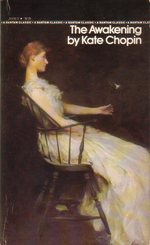 The Awakening
The Awakening
by Kate Chopin

Author: Serena M. Agusto-Cox at Savvy Verse & Wit
For Louisiana, Entertainment Weekly says, “Chopin’s early feminist work, which presents a woman carving an identity for herself that has nothing to do with wifedom or motherhood, also serves as an engrossing immersion in the historical worlds of New Orleans and the Louisiana Gulf Coast.”
The Awakening by Kate Chopin is considered by many to be a work of Feminism, published in the early 1900s. Mrs. and Mr. Pontellier appear to have a mutual respect for one another and the relationship many married couples fall into, such as nods and certain looks that are read easily by one another. He is a broker and has very specific ideas about how much attention his wife should pay to the children. But despite their easy way with one another, there is something distant in their relationship, as he feels she does not value his conversation and she tries to tamp down her anguish about only being a mother and a wife.
While summering at Grand Isle, she comes to view their relationship much differently and that of her place in the world. Mrs. Pontellier can see from the actions of other mothers vacationing there that she is much different. She does not worship her children and she does not have all the sophistication of a societal wife. As she becomes aware of these differences, Robert Lebrun begins to pay her special attention, which recalls for her many youthful infatuations. However, when Alcee Arobin crosses her path, things begin to change dramatically for the reborn painter, Mrs. Pontellier.
Edna Pontellier returns to the city and begins to break with tradition, which raises her husband’s eyebrows. Chopin’s work is not so much about the liberation of a woman from societal expectations. It is an introspective look at how we present ourselves to our husbands, children, friends, and greater society. Our inner selves, our true selves — if they ever emerge — are buried deep within our private worlds. For many of us, our true self is only known by us and, in some cases, not even then. Edna has been awakened to her true self and she embarks on a journey to realize it fully.
“She was becoming herself and daily casting aside that fictitious self which we assume like a garment with which to appear before the world.”
In terms of the setting, it’s clear that they live in Louisiana and music and art are strong cultural elements. The roots of French colonization remain in the area, and many of the people Edna interacts with speak French. Many of these people are definitely from the upper crust as they do little more than socialize, entertain one another, and gossip. The Awakening by Kate Chopin explores the consequences of becoming independent and stripping all pretension, leaving Edna in a solitary world (which mirrors the one she held close prior to her awakening). However, it seems as though Edna fails to evolve, merely bringing her inner world to the surface to find that she cannot survive, rather than exploring what that means and how she should move forward.
RATING: Tercet
About the Author
Kate Chopin was an American novelist and short-story writer best known for her startling 1899 novel, The Awakening. Born in St. Louis, she moved to New Orleans after marrying Oscar Chopin in 1870. Less than a decade later Oscar’s cotton business fell on hard times and they moved to his family’s plantation in the Natchitoches Parish of northwestern Louisiana. Oscar died in 1882 and Kate was suddenly a young widow with six children. She turned to writing and published her first poem in 1889. The Awakening, considered Chopin’s masterpiece, was subject to harsh criticism at the time for its frank approach to sexual themes. It was rediscovered in the 1960s and has since become a standard of American literature, appreciated for its sophistication and artistry. Chopin’s short stories of Cajun and Creole life are collected in Bayou Folk (1894) and A Night in Acadie (1897), and include “Desiree’s Baby,” “The Story of an Hour” and “The Storm.”



S. C. Flynn
Great book – good to see!